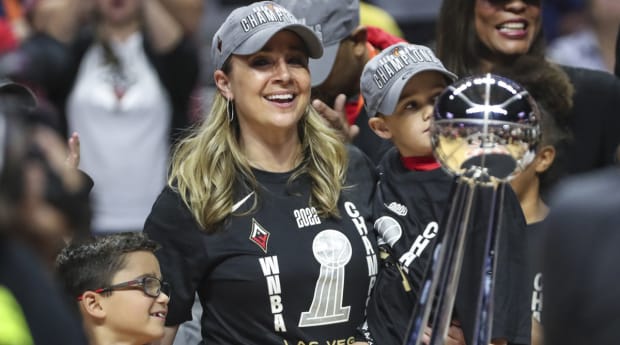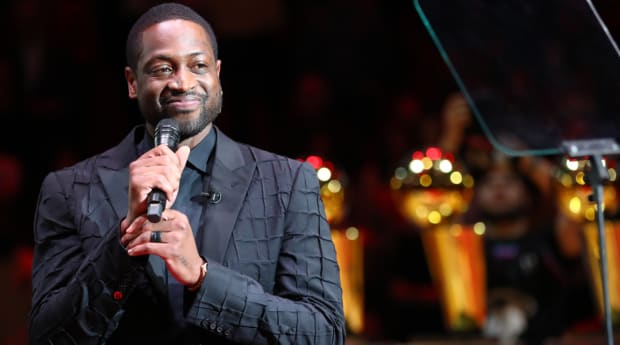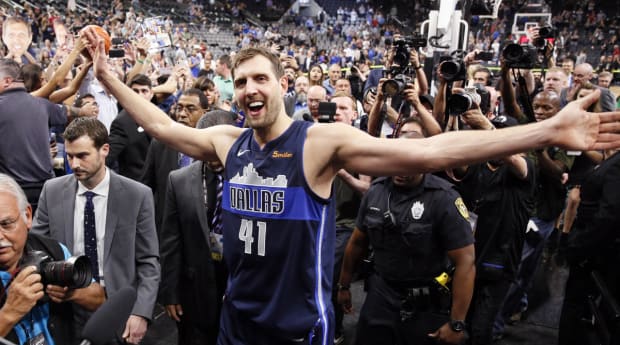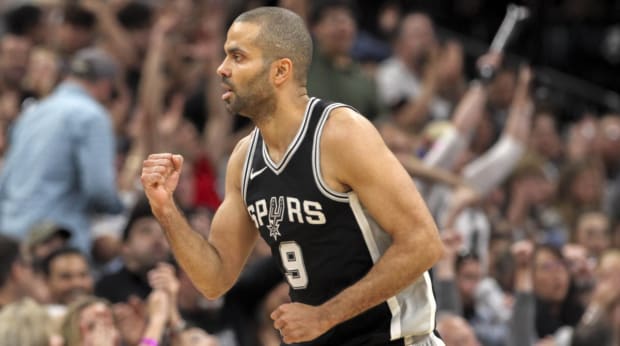It goes without saying that the Basketball Hall of Fame honors its absolute best each summer. But perhaps more than any other Hall of Fame class in basketball history, this year’s group beautifully encompasses the ever-changing nature of the sport.
On Saturday evening, in no particular order, we’ll see the NBA’s winningest coach—who also has the most highly touted rookie in recent memory—inducted. We’ll see one of his protégés, who first had an all-time WNBA playing career before winning a WNBA crown in her first year as coach, enter the Hall. Three international stars will be enshrined, fitting timing given that the league has seen its past five regular-season MVP awards taken by foreign players. And a star who helped usher in the NBA’s superteam and player-empowerment era will take his place in history at a time when today’s stars are landing deals worth $50 and $60 million annually.
More Hall of Fame Coverage: How the 1976 Olympic Women’s Team Forever Changed Sports
Here’s a look at each superstar’s bona fides on the eve of their Hall of Fame induction.
Gregg Popovich

Scott Coleman/IMAGO
Arguably no person in NBA history has illustrated finding more ways to win than Popovich, who’s earned five championship rings, but never in back-to-back years. The beauty in that: It meant the Spurs couldn’t simply roll out the same championship roster, with no personnel or style changes, and expect to repeat. Fine-tuning took place and fortified San Antonio more.
It wasn’t easy. Hell, at one point in 1999, before he’d won big, Popovich called Avery Johnson and David Robinson over to his home and told them he suspected he’d be fired if the underachieving team dropped its next game against the Rockets the following day. It lit an enormous fire under the club, which went on a tear—winning 31 of the final 36 regular-season contests—and essentially never looked back. With second-year star Tim Duncan and Robinson, a former MVP, the Spurs won the title by going big in ’99 before doing so again in 2003. Yet the makeup of the roster was fundamentally different in ’05 and again in ’07, by the time ballhandlers Tony Parker and Manu Ginóbili were impossible-to-guard fixtures for San Antonio. Still, San Antonio won titles in those seasons under Popovich.
And in 2014, when the Spurs picked themselves off the mat after losing a devastating NBA Finals in ’13, it was yet another iteration of the group. Popovich’s team—still featuring Duncan, Parker and Ginóbili, but also boasting budding star Kawhi Leonard—played a tireless form of selfless basketball, prioritizing ball movement over individual displays of stardom. The effort allowed them to dispatch the star-laden Heat in five games and dominate Miami on the sport’s biggest stage for a fifth title. (Not to be overlooked: Under Popovich, the Spurs made the playoffs for an NBA-record 22 consecutive years.)
Popovich, now 74, remains in the Spurs’ lead chair. And in a way, he now picks up largely where he began his San Antonio career: with a potentially generational big man on the roster, hoping for another run of contention.
Becky Hammon

Wendell Cruz/USA TODAY Sports
The longtime point guard didn’t have it easy coming up. Even as a big-time scorer, Hammon’s skill and talent flew a bit under the radar, leaving her lightly recruited at the high school level before heading to Colorado State, then going undrafted as she entered the professional ranks.
But she made those choices look silly relatively quickly, showing her chops as not only a sharpshooter but also a tough-minded ballhandler with pristine court vision and a bit of a rugged playing style. She began her career with the New York Liberty and was a fan favorite there before being traded to the San Antonio Silver Stars, where she’d have the best scoring seasons of her career, logging 18.8, 17.6 and 19.5 points per contest in 2007, ’08 and ’09, respectively. (Hammon, who led the Silver Stars to the WNBA Finals in ’08, became the seventh player in WNBA history to hit the 5,000-point mark for a career.)
Hammon sustained what would be a career-ending ACL tear in San Antonio in 2013. During her rehab, Popovich allowed her to sit in on Spurs practices and coaches’ meetings before inviting her to join the staff in ’14 as the first full-time female assistant coach in league history. And since leaving that position in late ’21, Hammon became the first WNBA coach to win the title in her first season, potentially beginning a dominant coaching run of her own with the Las Vegas Aces.
Dwyane Wade

Kim Klement/USA TODAY Sports
For a time, around when he spearheaded the Heat’s first championship in 2006, the Marquette product was arguably the NBA’s best player.
Wade wasn’t necessarily the best perimeter shooter. But if and when he rose from midrange, he was a constant threat. And outside of the long-range jumper, he did nearly everything else at a high level. Wade was a fantastic playmaker, an incredible defender for his size—despite standing just 6'4", he has the most blocks in NBA history among guards—and, true to his nickname “Flash,” was spectacular as an elusive cutter who slashed to the basket when defenders least expected it. Even after that title season in 2006, on top of playing a huge role in aiding the U.S. winning the gold medal in the ’08 Olympics, Wade won the scoring crown in ’09, averaging more than 30 points per night.
But his legacy grew to new, towering heights when he, LeBron James and Chris Bosh joined forces in Miami in the summer of 2010, winning two more titles for Wade and reaching four NBA Finals in just four seasons together. It was an unprecedented move that set off an eventual chain reaction of superteams (including Kevin Durant’s highly controversial choice to join the Warriors in ’16), and it’s the type we might not see again for a long, long time.
Either way you slice it, the history of the sport was changed because of Wade’s impact on it.
Dirk Nowitzki

Soobum Im/USA TODAY Sports
Back in 2011, Nowitzki had something to prove after years of playoff heartbreak.
The German star nearly reached the mountaintop in 2006, getting the Mavericks to the NBA Finals and even taking a 2–1 lead on Wade and the Heat. But Nowitzki struggled mightily to close the series as Wade dominated to close things out, leading Miami to its first title.
Then, for a few years, there was consistent heartbreak in Dallas. During the 2006–07 season, in which a dominant Nowitzki won his first and only league MVP award and the Mavs won an NBA-best 67 games, the squad entered as heavy first-round favorites against the Warriors only to lose the series in six games. The next season was equally disappointing, with Dallas dropping its first-round series in five games to the Hornets. In ’08–09, the Mavericks upset the Spurs to get out of the first round but then were swatted away by Denver. And history largely repeated itself in ’10, when Nowitzki and his team were bounced in the opening round for the third time in four seasons.
With all that failure in mind heading into the 2011 postseason, few believed the Mavs could actually get it done. Yes, Nowitzki was undoubtedly a worthy superstar—he’s sixth all time in scoring, and the sharpshooter’s legendary one-legged fadeaway has become one of the most adopted scoring moves in recent memory—but the Mavs’ star power came nowhere near that of Miami’s, with Wade, James and Bosh, once the NBA Finals rolled around.
Making matters worse, Nowitzki had torn a tendon in his finger on his left hand, and he’d developed a bad sinus infection and 101-degree fever ahead of Game 4 of the series, a malady that James and Wade infamously mocked before Game 5. Yet Nowitzki’s performance while under the weather was more than enough to help the Mavericks take the final three contests of the Finals and earn Dallas its first NBA title. Nowitzki was Finals MVP, averaging 26 points and nearly 10 rebounds in the shocking outcome that sent James and the Heat back to the drawing board.
Tony Parker

John Glaser/USA TODAY Sports
For all his incredible talent—and even his starting role as an NBA rookie—Parker didn’t have the full trust of Popovich right away. In fact, he often drew the ire of the coach. “I sometimes had tears in my eyes in the shower after practice. I told myself, ‘I’ll never be able to satisfy this coach. He’ll never be happy,’” Parker said.
But the point guard, a six-time All-Star and four-time All-NBA selection, eventually did. In classic Spurs fashion, he was highly coachable, even taking passionate critiques on film from Popovich at the coach’s home on Christmas Eve one year, according to Boris Diaw, a friend of Parker’s, and another former Spur who also hails from France. The attention to detail helped Parker win four titles with San Antonio.
Parker and Ginóbili certainly represented a sometimes-chaotic change of pace for what had been a bigger, more methodical club. Yet Parker’s speed and playmaking altered the calculus for the Spurs, making them harder to guard, particularly when the guard utilized his floater and his much-improved midrange jumper that he’d honed with assistant coach Chip Engelland.
The Frenchman remains an enormous Spurs fan and was ecstatic when the club won the rights to draft 7'4" French phenom Victor Wembanyama first. Parker has already broken bread with the big man, who he hopes will lead the next generation of greatness in San Antonio.
Pau Gasol

Steve Dykes/USA TODAY Sports
From the day the Lakers’ trade for Gasol went through with the Grizzlies, it was well understood in Los Angeles that the club had enough to win a championship, even though the two prior seasons had ended with first-round playoff exits.
Gasol joined Los Angeles in 2008, at a time when the Lakers desperately needed a big man—center Andrew Bynum dislocated his kneecap in an injury that would mark a sign of things to come—and with Gasol, the club immediately won the West and reached the NBA Finals. The Celtics managed to win that year, four games to two.
But the big man’s chemistry with Kobe Bryant and the Lakers’ roster only grew from there, helping the club add two NBA championship trophies to its vaunted case in the two years that followed in 2009 and ’10. Gasol, who hailed from Spain, was an incredibly talented post player, showcasing the ability to score with either hand. But he also illustrated great touch and comfort in stepping out a bit farther for jumpers. He was an impressive passer out of the post—making him an ideal fit for Phil Jackson’s triangle offense—in addition to being one of the game’s best rebounders.
Away from the court, Gasol was a huge fan of the opera and the symphony orchestra—a fitting interest for a player whose smooth game was music to the ears of his fans, particularly in Los Angeles.







